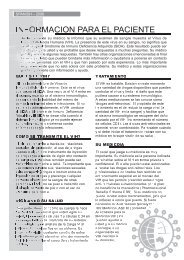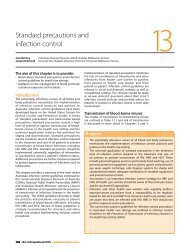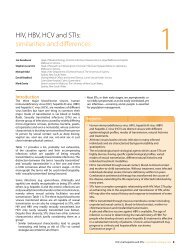B Positive – all you wanted to know about - ASHM
B Positive – all you wanted to know about - ASHM
B Positive – all you wanted to know about - ASHM
Create successful ePaper yourself
Turn your PDF publications into a flip-book with our unique Google optimized e-Paper software.
MANAGING PATIENTS WITH<br />
ADVANCED LIVER DISEASE<br />
Robert Batey University of New South Wales, Banks<strong>to</strong>wn Hospital, Banks<strong>to</strong>wn, NSW.<br />
Links <strong>to</strong>: Chapter 7: Treatment of chronic hepatitis B virus infection<br />
Chapter 9: Hepatitis B virus-related hepa<strong>to</strong>cellular carcinoma<br />
KEY POINTS<br />
� address the underlying HbV infection<br />
- define the severity of disease<br />
- offer anti-viral therapy where appropriate<br />
� Minimise other hepatic injury<br />
- exclude other causes of liver disease<br />
- advise on healthy living<br />
� Manage the complications of cirrhosis<br />
People with chronic hepatitis b virus (HbV)<br />
infection are at an increased risk of developing<br />
liver cirrhosis, hepatic decompensation<br />
and hepa<strong>to</strong>cellular carcinoma (Hcc), with<br />
15<strong>–</strong>40% developing serious sequelae during<br />
their lifetime. cirrhosis is a his<strong>to</strong>pathological<br />
diagnosis, describing liver fibrosis with nodule<br />
formation subsequent <strong>to</strong> liver cell necrosis and<br />
regeneration. fibrosis in response <strong>to</strong> hepa<strong>to</strong>cyte<br />
death is due <strong>to</strong> stellate cell activation and is at<br />
first limited in extent, then forms portal-<strong>to</strong>portal<br />
or portal-<strong>to</strong>-central vein bridging, fin<strong>all</strong>y<br />
leading <strong>to</strong> nodule formation. cirrhosis leads<br />
<strong>to</strong> altered liver perfusion with a decrease in<br />
portal vein flow and a compensa<strong>to</strong>ry increase<br />
in hepatic artery input. this adversely affects<br />
hepa<strong>to</strong>cyte function over time. nevertheless,<br />
patients with stable cirrhosis may survive many<br />
years without major complications.<br />
in HbV infection, the progression of<br />
inflamma<strong>to</strong>ry and fibrotic processes is more<br />
active in those with raised aLt levels and in<br />
those with a high HbV dna.<br />
Patients with advanced liver disease, with<br />
or without ongoing hepatitic inflammation,<br />
8<br />
present clinicians with significant management<br />
ch<strong>all</strong>enges. the presence of untreated or<br />
untreatable HbV or hepatitis c virus (HcV)<br />
infection or continuing damage from other<br />
fac<strong>to</strong>rs, such as alcohol use or non alcoholic<br />
fatty liver disease, or insulin resistance, adds<br />
<strong>to</strong> the complexity of the management process.<br />
if treated well, these patients may still enjoy<br />
months <strong>to</strong> years of an acceptable quality of<br />
life, even if the underlying condition cannot be<br />
cured. ultimately, liver transplantation provides<br />
a better outcome if it can be achieved, but this<br />
is not realistic for many patients. this chapter<br />
will focus on the management of advanced liver<br />
disease in patients with chronic HbV infection.<br />
there are three issues that should be addressed<br />
in managing this group of patients.<br />
1. Addressing the underlying HBV<br />
infection<br />
the treatment of chronic HbV is discussed<br />
in detail in chapter 7: treatment of chronic<br />
hepatitis b virus infection. <strong>all</strong> patients should<br />
be evaluated for possible antiviral therapy with<br />
pegylated interferon or an oral nucleoside or a<br />
nucleotide analogue agent such as entecavir,<br />
as these drugs can significantly modify the<br />
b <strong>Positive</strong> <strong>–</strong> <strong>all</strong> <strong>you</strong> <strong>wanted</strong> <strong>to</strong> <strong>know</strong> <strong>about</strong> hepatitis b: a guide for primary care providers 65






